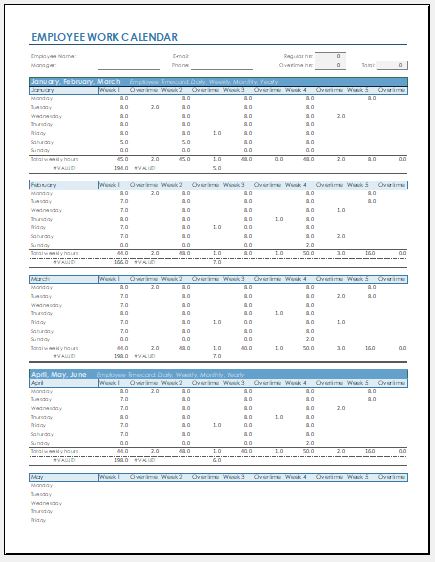Employee Work Calendars
Employee daily, weekly, and monthly work calendars are also known as employee work schedules. They are so-called because they relate to managing all employees’ shifts. This means this work calendar is best for organizations centered on shift-based work.
All those who have worked under such conditions will know how important scheduling is to running operations smoothly and allowing organizations to plan better. Scheduling also helps the entity track labor costs, unpaid leaves or breaks, and any changes in schedules and paychecks. If the employee finds this work calendar easy to understand and readable, it can also be a perfect communication tool.
This excellent tool is most commonly used by the organization’s managers, who must schedule each employee’s working hours decently. Each work calendar is dedicated to one employee. That is why it mentions the name of the concerned employee at the top of the calendar and the name of the manager to whom the specific employee reports.
After mentioning the overall contact details, the hours he usually works and any overtime he does should also be mentioned. This work calendar is drafted in a calendar format, with sections made in the monthly form and further divided into rows and columns.
The first column will bear the days of the week, while the first row will mention the number of weeks. In the cells corresponding to the correct number of weeks and days, you should also mention the number of hours worked and the overtime. In this way, calculating the total hours an employee has worked for the better functioning of the organization gets a lot easier.
The manager can calculate the total hours worked a day, a week, and even a month. The best way to make this work calendar hassle-free is to use a template. This will ensure that a professional pattern is followed and that it is easy to understand.
Preview

File Size: 55 KB -Format: MS Excel
- Product Sales Tracker Template
- Debit Memo Template for Excel
- Winter Attire Inventory
- Financial Projections Worksheet
- Employee Absence Tracker
- Weekly Sales Report Template
- Budget Vs Actual Statement
- Remote Work Attendance Tracker
- Mileage Expense Report Template
- Fitness Calendar Template
- Project Gantt Chart
- Daily Attendance Tracker for an Individual Employee
- Overtime Hours Tracker Template
- Vacation and Leave Tracker Template
- Departmental Expense Report Template
← Previous Article
Visitor Entry RegisterNext Article →
Closing Cash Register
Leave a Reply